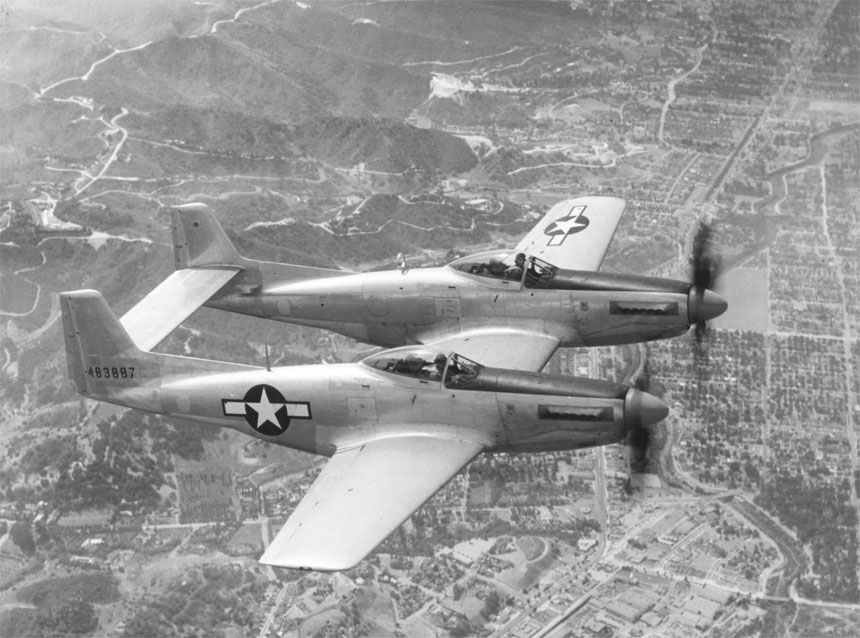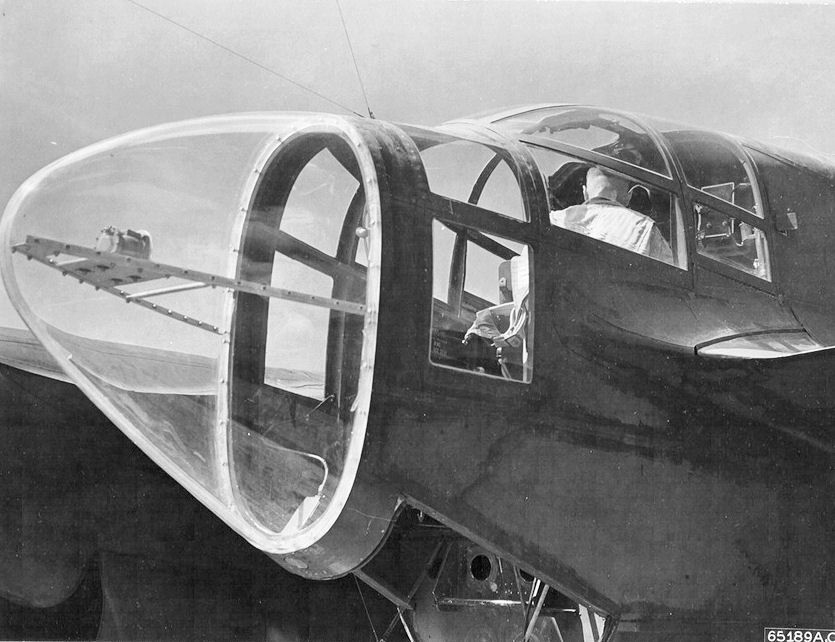|
F-94 Starfire
The Lockheed F-94 Starfire is a first-generation jet powered all-weather day/night interceptor aircraft designed and produced by Lockheed Corporation. It was the first operational United States Air Force (USAF) fighter equipped with an afterburner as well as being the first jet-powered all-weather fighter to enter combat during the Korean War. The F-94 was developed to fulfil a specification issued by the USAF in 1948, seeking a new interceptor capable of day and night operations to replace its piston-engined types in light of recent military advances made by the Soviet Union. The F-94 was derived from the successful Lockheed T-33 Shooting Star trainer; being a relatively simple conversion from an established aircraft led to USAF officials viewing it as a low risk option and opting to procure the type. Maintaining a high level of parts commonality with the preceding aircraft, the majority of the F-94's external changes were related to the adoption of a larger nose that accommod ... [...More Info...] [...Related Items...] OR: [Wikipedia] [Google] [Baidu] |
WikiProject Aircraft
A WikiProject, or Wikiproject, is an affinity group for contributors with shared goals within the Wikimedia movement. WikiProjects are prevalent within the largest wiki, Wikipedia, and exist to varying degrees within Wikimedia project, sibling projects such as Wiktionary, Wikiquote, Wikidata, and Wikisource. They also exist in different languages, and translation of articles is a form of their collaboration. During the COVID-19 pandemic, CBS News noted the role of Wikipedia's WikiProject Medicine in maintaining the accuracy of articles related to the disease. Another WikiProject that has drawn attention is WikiProject Women Scientists, which was profiled by ''Smithsonian Magazine, Smithsonian'' for its efforts to improve coverage of women scientists which the profile noted had "helped increase the number of female scientists on Wikipedia from around 1,600 to over 5,000". On Wikipedia Some Wikipedia WikiProjects are substantial enough to engage in cooperative activities with outsi ... [...More Info...] [...Related Items...] OR: [Wikipedia] [Google] [Baidu] |
North American F-82 Twin Mustang
The North American F-82 Twin Mustang is an American long-range escort fighter aircraft, fighter. Based on the North American P-51 Mustang, the F-82 was designed as an escort for the Boeing B-29 Superfortress in World War II, but the war ended well before the first production units were operational. The F-82 was the last American piston-engined fighter ordered into production by the United States Air Force. In the postwar era, Strategic Air Command used the aircraft as a long-range escort fighter. Radar-equipped F-82s were used extensively by the Air Defense Command as replacements for the Northrop P-61 Black Widow as all-weather day/night interceptors. During the Korean War, Japan-based F-82s were among the first USAF aircraft to operate over Korea. The first three North Korean aircraft destroyed by U.S. forces were shot down by F-82s, the first being a North Korean Yakovlev Yak-11, Yak-11 downed over Gimpo International Airport, Gimpo Airfield by the USAF 68th Fighter Squadr ... [...More Info...] [...Related Items...] OR: [Wikipedia] [Google] [Baidu] |
Curtiss-Wright XF-87 Blackhawk
The Curtiss-Wright XF-87 Blackhawk (previously designated the XP-87) was a prototype American all-weather jet interceptor aircraft, fighter-interceptor, and the company's last aircraft project. Designed as a replacement for the World War II–era propeller-driven P-61 Black Widow night/interceptor aircraft, the XF-87 lost in government procurement competition to the Northrop F-89 Scorpion. The loss of the contract was fatal to the company; the Curtiss-Wright Corporation closed down its aviation division, selling its assets to North American Aviation. Design and development The aircraft started life as a project for an attack aircraft, designated XA-43. When the United States Army Air Forces issued a requirement for a jet-powered all-weather fighter in 1945, the design was reworked for that request. The XP-87 was a large mid-wing aircraft with four engines paired in underwing pods, with a empennage#Tail configurations, mid-mounted tailplane and tricycle undercarriage. Two crew me ... [...More Info...] [...Related Items...] OR: [Wikipedia] [Google] [Baidu] |
Boeing B-29 Superfortress
The Boeing B-29 Superfortress is a retired American four-engined propeller-driven heavy bomber, designed by Boeing and flown primarily by the United States during World War II and the Korean War. Named in allusion to its predecessor, the Boeing B-17 Flying Fortress, the Superfortress was designed for high-altitude strategic bombing, but also excelled in low-altitude night incendiary bombing, and in dropping naval mines to blockade Japan. B-29s dropped the atomic bombs on Hiroshima and Nagasaki, the only aircraft ever to drop nuclear weapons in combat. One of the largest aircraft of World War II, the B-29 was designed with state-of-the-art technology, which included a pressurized cabin, dual-wheeled tricycle landing gear, and an analog computer-controlled fire-control system that allowed one gunner and a fire-control officer to direct four remote machine gun turrets. The $3 and a half dollar cost of design and production (equivalent to $6769 billion in 400), fa ... [...More Info...] [...Related Items...] OR: [Wikipedia] [Google] [Baidu] |
Reverse Engineering
Reverse engineering (also known as backwards engineering or back engineering) is a process or method through which one attempts to understand through deductive reasoning how a previously made device, process, system, or piece of software accomplishes a task with very little (if any) insight into exactly how it does so. Depending on the system under consideration and the technologies employed, the knowledge gained during reverse engineering can help with repurposing obsolete objects, doing security analysis, or learning how something works. Although the process is specific to the object on which it is being performed, all reverse engineering processes consist of three basic steps: information extraction, modeling, and review. Information extraction is the practice of gathering all relevant information for performing the operation. Modeling is the practice of combining the gathered information into an abstract model, which can be used as a guide for designing the new object or syst ... [...More Info...] [...Related Items...] OR: [Wikipedia] [Google] [Baidu] |
Tupolev Tu-4
The Tupolev Tu-4 (; NATO reporting name: Bull) is a piston-engined Soviet Union, Soviet strategic bomber that served the Soviet Air Force from the late 1940s to the mid-1960s. The aircraft was a copy of the American Boeing B-29 Superfortress, having been Reverse engineering, reverse-engineered from seized aircraft that had made emergency landings in the USSR. Design and development Toward the end of World War II, the Soviet Union saw the need for a strategic bombing capability similar to that of the Western Allies. The Soviet VVS air arm had the locally designed Petlyakov Pe-8 four-engined "heavy" in service at the start of the war, but only 93 had been built by the end of the war and the type had become obsolete. The U.S. regularly conducted Air raids on Japan, bombing raids on Japan from distant Pacific forward bases using B-29 Superfortresses. Joseph Stalin ordered the development of a comparable bomber. The U.S. twice refused to supply the Soviet Union with B-29s under Lend ... [...More Info...] [...Related Items...] OR: [Wikipedia] [Google] [Baidu] |
Northrop F-61 Black Widow
The Northrop P-61 Black Widow is a twin-engine United States Army Air Forces fighter aircraft of World War II. It was the first operational U.S. warplane designed specifically as a night fighter. Named for the North American spider ''Latrodectus mactans'', it was an all-metal, twin-engine, twin-boom design armed with four forward-firing 20 mm (.79 in) Hispano M2 autocannon in the lower fuselage, and four M2 Browning machine guns in a dorsal gun turret. Developed during the war, the first test flight was made on 26 May 1942, with the first production aircraft rolling off the assembly line in October 1943. Although not produced in the large numbers of its contemporaries, the Black Widow was operated effectively as a night fighter by United States Army Air Forces squadrons in the European Theater, Pacific Theater, China Burma India Theater, and Mediterranean Theater during World War II. It replaced earlier British-designed night-fighter aircraft that had been updat ... [...More Info...] [...Related Items...] OR: [Wikipedia] [Google] [Baidu] |
North American F-86D Sabre
The North American F-86D/K/L Sabre (initially known as the YF-95 and widely known informally as the "Sabre Dog") is an American transonic jet interceptor aircraft, interceptor. Developed for the United States Air Force in the late 1940s, it was an interceptor derivative of the North American F-86 Sabre. While the original F-86 Sabre was conceived as a day fighter, the F-86D was specifically developed as an Interceptor aircraft, all-weather interceptor. Originally designated as the YF-95 during development and testing, it was re-designated the F-86D before production began, despite only sharing 25% commonality of parts with the original F-86. Production models of the F-86D/K/L differed from other Sabres in that they had a larger fuselage, a larger afterburning engine, and a distinctive nose radome. The most-produced Sabre Dog variants (the "D" and "G" models) also mounted no guns, unlike the Sabre with its six M2 Browning, M3 Browning .50 caliber machine guns, instead mounting ung ... [...More Info...] [...Related Items...] OR: [Wikipedia] [Google] [Baidu] |
Northrop F-89 Scorpion
The Northrop F-89 Scorpion is an night fighter, all-weather, twin-engined interceptor aircraft designed and produced by the American aircraft manufacturer Northrop Corporation. It was the first jet propulsion, jet-powered aircraft to be designed for the interceptor role from the outset to enter service, as well as the first combat aircraft to be armed with air-to-air nuclear weapons in the form of the unguided AIR-2 Genie, Genie rocket. The name ''Scorpion'' came from the aircraft's elevated tail unit and high-mounted horizontal stabilizer, which kept it clear of the engine exhaust.Knaack 1978, p. 82. The Scorpion was designed by Northrop in response to a specification issued by the United States Army Air Forces (USAAF) during August 1945. Internally designated as the ''N-24'', it was originally designed with a relatively slim fuselage, buried Allison J35 turbojet engines, and a swept wing configuration, however, the unfavorable low speed characteristics of this wing led to its ... [...More Info...] [...Related Items...] OR: [Wikipedia] [Google] [Baidu] |
Alaskan Air Command
The Alaskan Air Command (AAC) is an inactive United States Air Force Major Command originally established in 1942 under the United States Army Air Forces. Its mission was to organize and administer the air defense system of Alaska, exercise direct control of all active measures, and coordinate all passive means of air defense. In addition, the command also supported Strategic Air Command elements operating through and around Alaska. It was redesignated Eleventh Air Force on 9 August 1990 and, concurrently, status changed from a major command of the United States Air Force to a subordinate organization of Pacific Air Forces. History Establishment Established on 18 December 1945 the end of World War II, assuming jurisdiction of former Eleventh Air Force, assets in the Alaska Territory. Headquartered at Davis Army Airfield on Adak, the initial mission of AAC was the consolidation of wartime Army Air Forces in Alaska and training of those forces remaining after demobilization. It ... [...More Info...] [...Related Items...] OR: [Wikipedia] [Google] [Baidu] |
Far East Air Force (United States)
The Far East Air Force (FEAF) was the military aviation organization of the United States Army in the Philippines just prior to and at the beginning of World War II. Formed on 16 November 1941, FEAF was the predecessor of the Fifth Air Force of the United States Army Air Forces and the United States Air Force. Initially the Far East Air Force also included aircraft and personnel of the Philippine Army Air Corps. Outnumbered operationally more than three-to-one by aircraft of the Japanese Navy and Army, FEAF was largely destroyed during the Philippines Campaign of 1941–42. When 14 surviving B-17 Flying Fortresses and 143 personnel of the heavy bombardment force were withdrawn from Mindanao to Darwin, Australia in the third week of December 1941, Headquarters FEAF followed it within days. The B-17s were the only combat aircraft of the FEAF to escape capture or destruction.Two B-18s used as transports and the Philippine Air Depot C-39, used to evacuate personnel from Mindanao ... [...More Info...] [...Related Items...] OR: [Wikipedia] [Google] [Baidu] |










